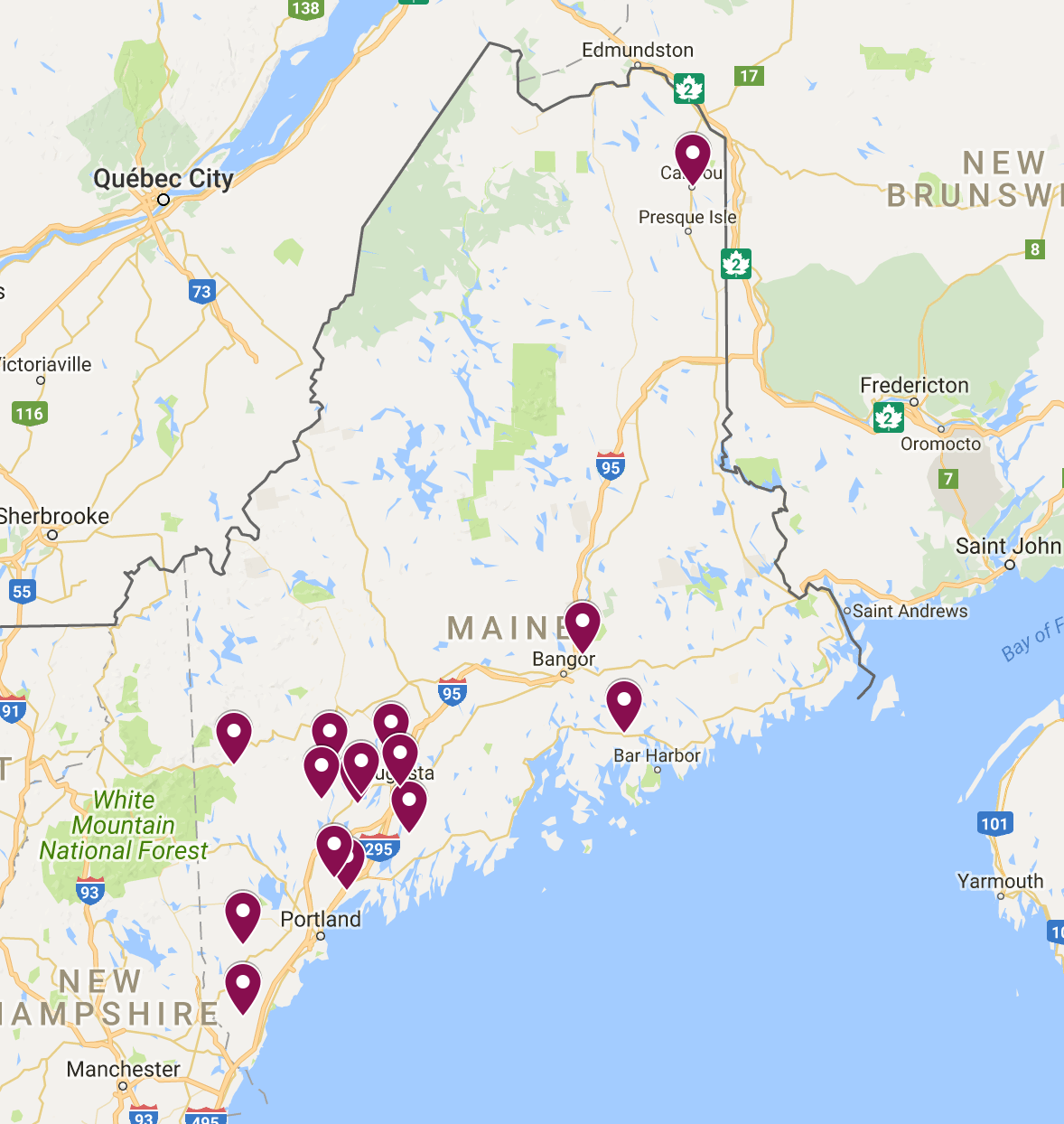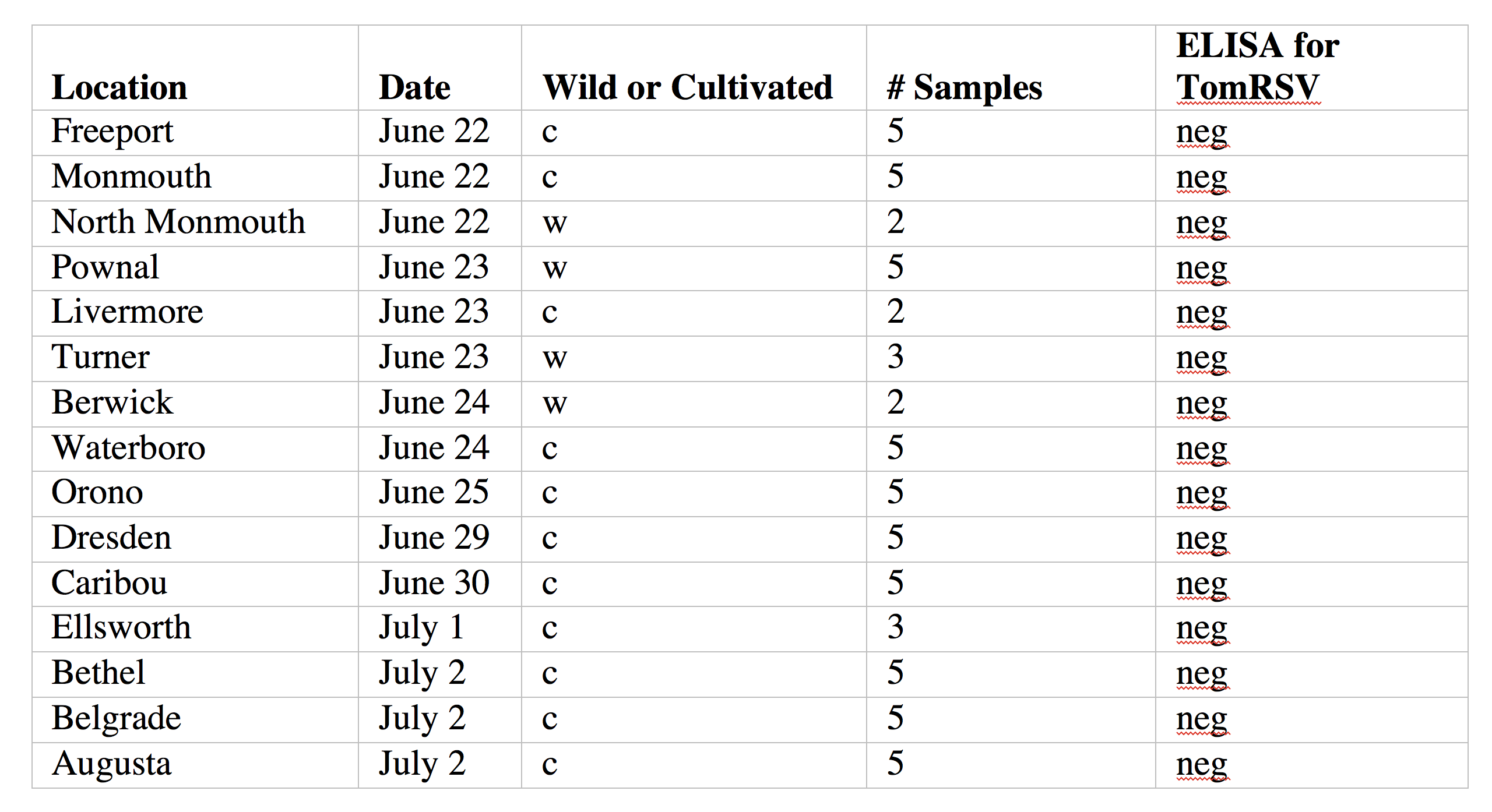Journal of the NACAA
ISSN 2158-9429
Volume 11, Issue 1 - June, 2018
A Survey Of Maine’s Wild and Cultivated Elderberries for Tomato Ringspot Virus
- Jackson, T. L., County Educator, Agriculture And Natural Resources, University Of Maine Cooperative Extension
ABSTRACT
Cooperating elderberry growers participated in a survey to determine if Tomato Ringspot Virus is present in wild and cultivated crops in Maine. Elderberries (Sambucus canadensis and Sambucus nigra) are susceptible to Tomato Ringspot Virus (TomRSV), which could limit how long cultivated orchards remain productive. Fifty-seven wild and cultivated plants were sampled, none of which tested positive for TomRSV, using ELISA (enzyme linked immunosorbent assay). The absence of the virus in this survey has cleared the way for future research, including a variety trial, to be conducted in Maine beginning in 2018.
Introduction
Maine is home to the largest producer of certified organic American elderberries (Sambucus canadensis) in the U.S. (Eldertide Farm in Dresden), and there is increasing interest in the commercial production of elderberries. The fruit and flowers are used for products from wines, pies and jams to food-grade dyes and high-antioxidant syrups and dietary supplements (Charlebois, et al., 2010). Given the availability of suitable land and favorable growing conditions, there is the potential for Maine to become a national leader in elderberry production.
A group of part-time and commercial elderberry growers approached University of Maine Cooperative Extension regarding basic research in elderberries as a commercial crop. In response, a growers’ meeting was held at the Extension office in Lisbon Falls on February 10, 2015. About thirty growers attended the meeting to learn about basic cultivation practices and give feedback on their research and other technical support needs. The highest-priority issue that arose during the meeting, and through a subsequent survey, was determining which diseases impact elderberries. Fungal diseases are most common, but can be managed. Elderberries are also susceptible to several viruses, including Tomato Ringspot Virus (TomRSV), for which there is no treatment or cure. Current and potential commercial elderberry producers may be limited in how long their orchards will be productive by TomRSV (Way, 1981). It is suspected that the virus is responsible for the dramatic loss of wild, native elderberries beginning in the 1960’s (D. Handley, personal communication, 2015).
A survey study was designed to determine if TomRSV is already infecting elderberries in Maine. The presence of the virus could impact any further research as well as recommendations about increasing commercial acreage. Funding was secured for the survey to determine the presence or absence of TomRSV in both wild and cultivated elderberries from around the state. Tissue samples were collected and tested at an independent laboratory during the summer of 2015.
Methods
Suggestions of locations for taking tissue samples were solicited from the list of growers who had come to the meeting in February, as well as from colleagues within UMaine Extension and the Maine Department of Agriculture, Conservation and Forestry. In addition to cultivated plots, location data were gathered for wild elderberries from those who commonly forage them in the fall. With enough funding for up to sixty tissue samples, a map (Figure 1) and a route were devised for taking samples during two weeks in late June and early July, 2015, when most elderberries were in bloom. Locations included Freeport, Monmouth, North Monmouth, Pownal, Livermore, Turner, North Berwick, North Waterboro, Orono, Dresden, Caribou, Ellsworth, Bethel, Belgrade, and Augusta.

Figure 1. Map of Elderberry Sampling Locations in Maine. Map data ©2015 Google
Results
Regardless of whether elderberry plants were wild, cultivated, appeared sick or healthy, none of the 62 samples tested positive for TomRSV (Table 1).
Table 1. Sampling Locations, Dates and Results of ELISA Testing For TomRSV.

The vast majority of commercial growers in Maine are interested in producing flowers and fruit of Sambucus canadensis, the native species of elderberry that grows in Maine. Worldwide, most medicinal elderberry products are derived from Sambucus nigra, the European species (Schmitzer et al., 2012). Several samples (n=3) were taken of S. nigra plants (var. Haschburg and Samyel), where they could be found, though the remaining (n=54) were of S. canadensis.
Discussion and Conclusion
The fact that elderberry plants infected with TomRSV were not found is not being interpreted as a definitive answer to the question of whether or not the virus is present in Maine's wild population or cultivated plots, however, not being able to find it easily is a good sign. It is possible that a better survey would have been to sample for the soil-borne dagger nematodes (Xiphinema sp.) which vector the disease (Jones, 1972). Given the amount of funding available, the tissue sample survey was a better option.
This survey was a benchmark to determine whether time and funds should be invested in the installation of a variety trial in Maine. There is good data from growers and researchers around New England, particularly Vermont, on varieties that can survive the harsh northeast winters and produce fruit before the first frost in September. Given the variation of growing conditions within Maine, growers are requesting a local trial.
The current and potential commercial elderberry growers in Maine have expressed a great deal of appreciation that, rather than dismiss their requests for basic research on this crop based on the conventional wisdom that TomRSV would prevent their future success, Extension was willing to conduct this survey first. It would have been difficult to convince some collaborating researchers and funders that expanded trials are worth doing without some sense of whether they would be doomed to fail. In addition to clearing the way for a variety trial to proceed, this survey earned good will from a heretofore underserved segment of small fruit producers in Maine. As Nicholas and Hinkley (2011) recommend, involving the growers from the beginning as collaborators has led to excellent ongoing relations with the group.
Following the results of this survey, additional funds were solicited and received for the installation of a variety trial at Highmoor Farm, a University of Maine Research Station in Monmouth, in 2018.
Literature Cited
Charlebois, D., Byers, P.L., Finn, C.E. and Thomas, A.L. (2010). Elderberry: horticulture, botany, potential. Horticulture Review, Amer. Soc. Hort. Sci. 37:213–280.
Handley, D. (2015, February 10). Personal Interview. University of Maine Cooperative Extension.
Jones, A.T. (1972). Purification and properties of elderberry latent virus, one of four sap-transmissible viruses obtained from American elder (Sambucus canadensis L.). Annals of Applied Biology 70:49-58.
Nicholas, K.A. and Hinkley, E.S. (2011). Conducting research on private farms and ranches: Approaches, issues, and tips. Journal of Extension 49(6), 6TOT11. Available at https://www.joe.org/joe/2011december/tt11.php.
Schmitzer, V., Veberic, R., and Stampar, F. (2012). European elderberry (Sambucus nigra L.) and American Elderberry (Sambucus canadensis L.): Botanical, chemical and health properties of flowers, berries and their products. In C. Tuberoso (Ed.), Berries: Properties, Consumption and Nutrition. Hauppauge, New York: Nova Biomedical.
Way, R.D. (1981). Elderberry culture in New York State. New York's Food and Life Sciences Bulletin 91:1-4. New York State Agricultural Experimental Station, Geneva, NY.
Acknowledgements
Funding for the survey was provided by the University of Maine Food and Agriculture Center. My sincere appreciation goes to the growers who allowed me to take samples from their plots and to all who directed me towards wild elderberries in their neighborhoods.
